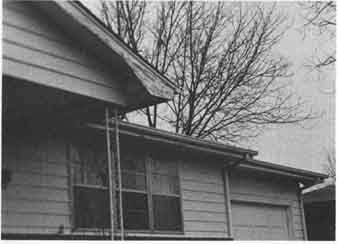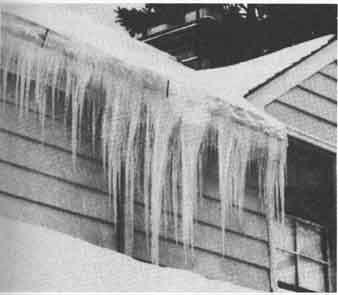AMAZON multi-meters discounts AMAZON oscilloscope discounts
All the cooking, washing, bathing, showering, and even overly misting the flowers are too much for a house that is not allowed to breathe. Even our own breathing adds almost 2 pounds of moisture every day to the house.
That is a mist you are exhaling right now. The symptoms of terminal ventilation diseases show stark and ugly on many homes.
BUCKING OR CURLING SHINGLES
Intense arid prolonged summer heat turns most attics into virtual ovens with temperatures of 140 degrees not uncommon. Hot spots form, and the roof shingles melt enough to start the curling process. In the winter, water gets trapped under those same shingles that have already been damaged by the summer sun. When the water freezes, the ice raises the shingles, and you get leaks from outside to drip on the insulation. Poor ventilation ruins a roof all the time—summer and winter.
ROOF DISCOLORATION
When a roof blackens, it is usually due to algae that is carried by the wind and deposited on roofs. They thrive on moisture, and they invariably indicate the attic is in bad shape. Sick attics often force the tar up out of the shingles. Intense condensation and mildew cause this bleeding. White shingles might even turn green, and sections of shingles will eventually be destroyed.
SWEATING WALLS
Inside or outside walls that sweat are telling you that they need ventilation. The paint gets ruined right along with all the attempts at energy efficiency. Mold and mildew run unchecked on many interior walls due to the wetness.
Condensation that is not visible inside the exterior walls can do much major damage. When people have removed walls during remodeling, they have been shocked to find they were very wet. Moisture passes through wood, shakes or shingles, bricks, and masonry if there is no vapor barrier to stop it. The condensation can freeze during the winter, wetting the walls and the insulation if there is any. The moisture then hits the back side of the interior wall. It penetrates the plaster or wall covering, and the damage comes all the way through.
When this condensation freezes, it wets the wood. After a few winters of this flood of water, the wood rots. When people start to remove what they think is a solid wall, they are sometimes surprised. Quite often there are open spots in the vapor barrier applied to the inside of the exterior walls. Some moisture might penetrate to the inside of the walls. Any excessive humidity inside the house will most likely end up coming through the porous wall, wreaking havoc on the walls as it passes through it.
PEELING PAINT ON THE EAVES
High temperatures, raining condensation, and trapped air push the paint off the eaves. Flaking paint on the cornice boards will be very noticeable. Eaves need cross ventilation, and care must be taken to see that these vents are not blocked by insulation. Intense heat gets trapped in this tight section of the house at times (Fig. 2-1). The moisture builds so high in many cases that you can see the water drops hanging from the eaves (often they drip).

Fig. 2-1. When paint peels on the eaves, there is usually poor attic
ventilation.
PEELING PAINT ELSEWHERE ON THE HOUSE
No air flow through the walls will start peeling off paint. The paint will not stick to dead walls. In some cases, the interior humidity comes light through the walls all the way to the outside. If there is no vapor barrier to stop the condensation, it sometimes passes right on through the wood— pushing the paint off from the inside. Humidity will work its way through any open spots in the insulation. If the insulation gets wet enough, it will just sponge water right on through it.
ICICLE FORMATION
Icicles might bring romantic scenes to mind, but they are one of the dearest signs of very poor ventilation. Warm air from inside the house comes through the insulation—if there is any—and melts the snow on the roof. It starts dripping and then re-freezes, creating icicles. Notice that they tend to cluster in certain areas rather than just all over. See Fig. 2-2.

Fig. 2-2. Icicles tend to cluster when there is inadequate attic
air conditions.
FROSTY, FROZEN, OR FOGGY WINDOWS
Houses that are too tight and have poor ventilation invariably have wet windows in the winter. When windows become waterfalls, they do tremendous damage by rotting the wood, ruining the paint or stain, and ruining the walls. Expensive curtains, drapes, and sheers are often permanently spotted with dirty water marks.
When the water is on the inside window, the storm window is leaking air. When the condensation is on the outside window, the inside window is admitting the air. Humid air from inside the room escapes through the window and condenses on the inside of the storm window. Sealing them well might stop this.
There are tiny circle vents, the size of a quarter, that can be placed around or below windows. These miniature vents often let the window and wall area breathe enough to prevent any condensation problems.
Prev.: Is Your
House Dying from a Lack of Air?
Next: Indoor Pollution